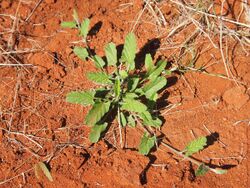Biology:Convolvulus clementii
| Desert bindweed | |
|---|---|

| |
| Scientific classification | |
| Kingdom: | Plantae |
| Clade: | Tracheophytes |
| Clade: | Angiosperms |
| Clade: | Eudicots |
| Clade: | Asterids |
| Order: | Solanales |
| Family: | Convolvulaceae |
| Genus: | Convolvulus |
| Species: | C. clementii
|
| Binomial name | |
| Convolvulus clementii Domin
| |
Convolvulus clementii, commonly known as desert bindweed, is a trailing perennial plant species, native to inland Australia . Mostly found on flat areas, like dune swales and claypans that are subject to seasonal inundation, in areas of open grassy woodland.[1]
Leaves variable in shape from base to tip of stem. White or pink flowers are produced predominantly from late winter to early spring but may be seen throughout the year.[2]
Seeds are dark brown to grey secteroid, 3 mm long, surface rugose and covered in hairs. The collection of seeds can be done January to December.[3]
The species was first formally described by Czech botanist Karel Domin in 1930 in Bibliotheca Botanica, based on a collection by Emile Clement between the Ashburton and De Grey Rivers.[4]
References
- ↑ "PlantNET". http://plantnet.rbgsyd.nsw.gov.au/cgi-bin/NSWfl.pl?page=nswfl&lvl=sp&name=Convolvulus~clementii.
- ↑ "Convolvulus clementii Domin". PlantNET - New South Wales Flora Online. Royal Botanic Gardens & Domain Trust, Sydney Australia. http://plantnet.rbgsyd.nsw.gov.au/cgi-bin/NSWfl.pl?page=nswfl&lvl=sp&name=Convolvulus~clementii.
- ↑ "Seeds of South Australia". https://spapps.environment.sa.gov.au/SeedsOfSA/speciesinformation.html?rid=1170.
- ↑ "Convolvulus clementii". Australian Plant Name Index (APNI), IBIS database. Centre for Plant Biodiversity Research, Australian Government, Canberra. http://www.anbg.gov.au/cgi-bin/apni?TAXON_NAME=Convolvulus+clementii.
External links
"Convolvulus clementii Domin". FloraBase. Western Australian Government Department of Parks and Wildlife. https://florabase.dpaw.wa.gov.au/browse/profile/. Wikidata ☰ Q5166607 entry
 |

